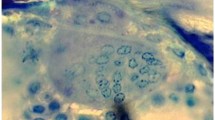Synopsis
The enzyme histochemical characteristics of osteoclasts in imprints of the metaphyseal regions of femurs, from male kittens aged approximately 18 weeks, were investigated. A selected number of enzymes representative of a variety of metabolic pathways were studied. The enzyme profile, time for the first appearance of detectable reaction product, intensity of the reactions, and localization of the reaction products were noted.
Osteoclasts are rich in enzymes, and metabolic pathways are well developed in respect of the utilization of the reduced coenzymes NADP and NADPH, succinic, malic, lactic, and isocitric acids, β-hydroxybutyrate and glucose-6-phosphate, the reactions being mediated by the diaphorases and dehydrogenases. The activities of acid and neutral phosphatases, non-specific esterases, and leucine naphthylamidase were high in these cells. However, little or no activity was demonstrated in respect of glutamate and α-glycerophosphate dehydrogenases or of aryl sulphatase, glucose-6-phosphatase and alkaline phosphatase.
Similar content being viewed by others
References
Addison, W. C. (1976).Properties and Functions of Odontoclasts. A comparative Study. Ph.D. Thesis. University of Birmingham.
Altman, F. P. (1969). The quantitative elution of Nitro-blue formazan from tissue sections.Histochemie 17, 319–26.
Altman, F. P. (1971). The use of a recording microdensitometer for the quantitative measurement of enzyme activities inside tissue sections.Histochemie 27, 125–36.
Andersen, H. &Hoyer, P. E. (1974). Simplified control experiments in the histochemical study of co-enzyme linked dehydrogenases.Histochemistry 38, 71–83.
Balogh, B. L. &Klapper, Z. F. (1961). Oxidative enzymes in the foreign body giant cell.J. Histochem. Cytochem. 9, 713–4.
Bitensky, L. (1972). The demonstration of lysosomes by the controlled temperature freezing-sectioning method.Q. Jl. micros. Sci. 103, 205–209.
Burstone, M. S. (1959). Histochemical demonstration of acid phosphatase activity in osteoclasts.J. Histochem. Cytochem. 7, 39–41.
Burstone, M. S. (1960). Histochemical demonstration of succinic dehydrogenase activity in osteoclasts.Nature 185, 866.
Chayen, J., Bitensky, L. &Butcher, R. G. (1973).Practical Histochemistry. London: John Wright.
Doty, S. B. (1972). Electron microscope localisation of hydrolytic enzymes in osteoclasts.Histochem. J. 4, 245–8.
Fullmer, H. M. (1964). Dehydrogenases in developing bone in the rat.J. Histochem. Cytochem. 12, 210–4.
Fullmer, H. M. (1966). Enzymes in mineralised tissues.Clin. Orthop. 48, 285–95.
Gahan, P. B. (1967). Lysosomes. In:Plant Cell Organelles. (Ed. J. B. Pridham). New York: Academic Press.
Gibson, W. A. &Fullmer, H. M. (1966). Histochemistry of the periodontal ligament. I. The dehydrogenases.Periodontics 4, 63–70.
Gibson, W. A. &Fullmer, H. M. (1967). Histochemistry of the periodontal ligament. II. The phosphatases.Periodontics 5, 226–32.
Gibson, W. A. &Fullmer, H. M. (1968). Histochemistry of the periodontal ligament. III. The esterases.Periodontics 6, 71–7.
Gibson, W. A. &Fullmer, H. M. (1974). Histochemistry of the periodontal ligament. IV. The aminopeptidases.J. Periodontics 45, 574–8.
Gomori, G. (1952).Microscopic Histochemistry. p. 193. Chicago: University Press.
Göthlin, G. &Ericsson, J. L. E. (1971). Fine structural localisation of acid phosphomonoesterase in the brush border region of osteoclasts.Histochemie 28, 337–44.
Gough, J. &Elves, M. W. (1967). Studies of lymphocytes and derivative cellsin vitro. Enzyme cytochemistry.Acta Haemotologica 37, 42–48.
Hermann-Erlee, M. P. (1961). A histochemical investigation of embryonic long bones. The effect of parathyroid hormone on the activity of a number of enzymes.Proc. kon. ned. Akad. Wet. 65C, 22–40.
Holt, S. J. &Withers, R. F. J. (1968). Studies in enzyme cytochemistry. V. An appraisal of indigogenic reactions for esterase localisation.Proc. Roy. Soc. B148, 520–32.
Hopsu-Havu, V. K., Arstila, A. U., Helminen, J. J. &Kalino, H. O. (1967). Improvements in the method for the electron microscopic localisation of aryl sulphatase.Histochemie 8, 54–64.
Lake, B. D. (1966). The histochemistry of phosphatases; the use of lead acetate instead of lead nitrate.Jl. R. microsc. Soc. 85, 73–5.
Laskin, D. M. &Engel, M. B. (1956). Bone metabolism and bone resorption after parathyroid extract.Arch. Path. 62, 296–302.
Lehninger, A. L. (1964).The Mitochondrion. New York: Benjamin.
Lojda, Z. (1962). Quoted by Pearse, A. G. E. In:Histochemistry. Vol. 1. 3rd Edn. p. 732. Boston: Little, Brown.
Lundin, L. G. &Allison, A. C. (1966). Acid hydrolase isoenzymes.Acta. Chem. Scand. 20, 2579–81.
Pearse, A. G. E. (1968).Histochemistry, Theoretical and Applied. 3rd Edn. London: Churchill Livingstone.
Pearse, A. G. E. (1972).Histochemistry, Theoretical and Applied. Vol. II. 3rd Edn. p. 1342. London: Churchill Livingstone.
Schajowicz, F. &Cabrini, R. L. (1960). Histochemical distribution of succinic dehydrogenase in bone and cartilage.Science 131, 1043–4.
Schofield, B. H., Levin, L. S. &Doty, S. B. (1974). Ultrastructure and lysosomal histochemistry of ia rat osteoclasts.Calc. Tissue Res. 14, 153–60.
Seligman, A. M., Karnovsky, M. J., Wasserkrug, H. L. &Haaker, J. S. (1968). Non-droplet ultrastructural demonstration of cytochrome oxidase activity with a polymerising osmiophilic reagent, diaminobenzidine (DAB).J. Cell Biol. 38, 1–14.
Severson, A. R., Tonna, E. A. &Pavelec, M. (1968). Application and evaluation of the lead-adenosine triphosphate method in skeletal tissue.Stain Technol. 43, 221–5.
Stuart, J. &Simpson, J. S. (1970). Dehydrogenase enzyme cytochemistry of unfixed leucocytes.J. Clin. Path. 23, 517–21.
Walker, D. G. (1961). Citric acid cycle in osteoblasts and osteoclasts. A histochemical study of normal and PTH treated rats.Bull. Johns Hopkins Hos. 108, 80–99.
Walker, D. G. (1972). Enzymatic and electron microscopic analysis of isolated osteoclasts.Calc. Tissue Res. 9, 296–309.
Warner, S. P. (1964). Hydrolytic enzymes in osteoclasts cultured in vitro.Jl. R. microsc. Soc. 83, 397–403.
Zugibe, F. T. (1970).Diagnostic Histochemistry. St. Louis: Mosby.
Author information
Authors and Affiliations
Rights and permissions
About this article
Cite this article
Addison, W.C. Enzyme histochemical properties of kitten osteoclasts in bone imprint preparations. Histochem J 10, 645–656 (1978). https://doi.org/10.1007/BF01003116
Received:
Revised:
Issue Date:
DOI: https://doi.org/10.1007/BF01003116




